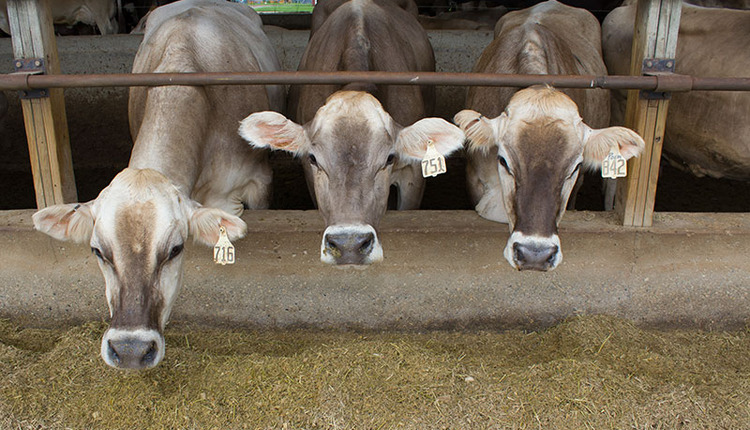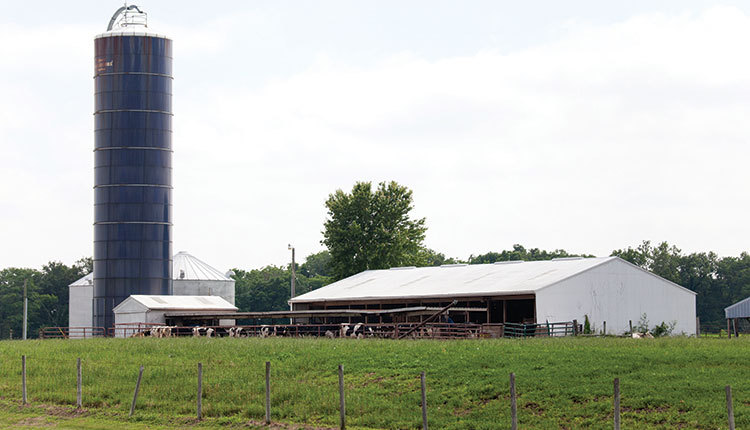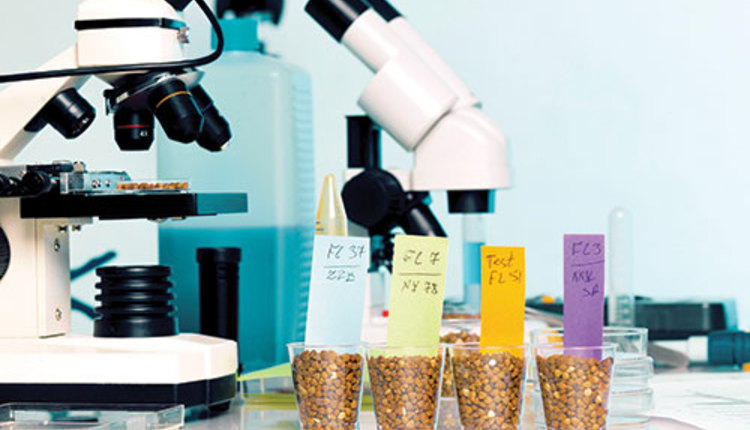
The author is a dairy nutrition consultant for Central Connecticut Cooperative Farmers in Hartford, Conn. He previously managed large dairies in California and Hawaii.
Even though yeast has been included in rations for many years and experts agree that it does benefit cows, there continues to be differing opinions as to how it works and whether live yeast is better than killed.
Over the past couple decades a host of companies have emerged, selling yeast as either live cell or killed cells with culture medium. The battle continues to rage over claims . . . each will improve rumen health and efficiency and boost intakes and milk production. Many brands now include enzymes and probiotics, as well.
Yeasts are tiny, single-celled plants, members of the fungus family. They are found everywhere and have been used for fermentation and baking since the earliest of times. The most common strain of yeast in commercial use today, including the dairy industry, is Saccharomyces cerevisiae.
Most of the serious research into yeast in dairy diets started in the mid-1980s with scientists investigating whether yeast would have a beneficial effect on the rumen environment of high-producing cows. Some of the important questions to be answered were:
1. Would yeast improve milk production?
2. What affect, if any, would yeast have on volatile fatty acid production and rumen pH?
3. Would yeast enhance rumen microbial growth?
The results of studies have been conflicting and varied. There have been a number of factors shown to impact these test results such as stage of lactation, types of forages fed, the forage-to-concentrate ratios, and whether TMRs are used. And to further complicate things, studies on live yeast strains compared to yeast cultures do little to make things any clearer. Strains of yeast, yeast viability, and yeast concentrations all may have an effect on trials and results.
There are several hypotheses of how yeast works. One suggests that the rumen environment is stabilized by the removal of oxygen in the rumen by the S. cerevisiae. Another supposes that yeast culture stimulates the growth of lactic acid-utilizing bacteria and stabilizes rumen acidity preventing it from dropping to a level that inhibits fiber-digesting bacteria from functioning. A third suggests that yeast improves microbial protein production by promoting ammonia uptake, thereby boosting microbial populations.
Manufacturers of live strains of yeast maintain that only live yeast strains can be active metabolically in the rumen to be of any benefit. Mode of action for live strains appears to center around their oxygen-scavenging ability, and this is their primary selling point. For microbes to live and grow in the rumen, they require an anaerobic environment. As the yeast grows, it removes oxygen from the rumen environment creating one that is more hospitable for microbe life.
On the other hand . . .
Manufacturers of killed strains state that the live strains cannot survive or remain viable in the harsh, acidic rumen environment. Only the yeast cell culture substrate material and accompanying metabolites is what favorably affects rumen function. Mode of action for yeast culture appears to center around the fact that the culture medium provides a very soluble carbohydrate source for the microbes.
Tammy Miller Webster, coordinator of the Rumen Fermentation Profiling Lab at West Virginia University, says she's not sold on the modification of the rumen environment theory, but neither does she completely discount it. Her work with continuous cultures in the lab yield inconsistent results with pH levels and VFA production. She explains that many of the responses to yeast are increases in microbial efficiency similar to responses seen in her rumen modifier studies. "We do consistently see an increase in microbial efficiency; a conversion of digested nutrients to microbial nitrogen," she states. "We tend to believe that the yeast cultures stimulate the bacteria . . . the result of organic growth factors."
Webster noted that, in some cases, she has seen a drop in pH due to the greater production of VFAs. While some studies have shown rises in VFAs, others have not. She explains that VFAs actually are a waste product of microbial fermentation. The evaluation of yeast's efficiency in the rumen is based upon whether the digested nutrients (carbohydrates) are converted either to VFA (waste) or to microbial nitrogen.
It appears that, with feeding yeast, you can have it both ways. In some cases, the rumen bacteria will produce more VFA which translates into more energy for the cow. In others, it appears there is more microbial bacteria produced which translates into more metabolizable protein available for absorption. It has been very difficult to establish whether live or killed yeasts do one or the other on any consistent basis. Others in the industry support the idea that a combination of live and killed yeasts in dairy diets may provide an even better advantage as opposed to offering one or the other. There could very well be a synergistic affect from the combination.
Studies also were done over 10 years ago to determine if the essential amino acid (EAA) profile of the microbial protein escaping the rumen might be altered. Again, results were mixed.
Other studies have looked at the improvement of fiber digestibility in early-lactation diets. Still others support the use of yeast during periods of heat stress.
Another study was conducted with laboratory continuous cultures to determine if live yeast would remain viable in rumen fluid. The conclusion of that study was that yeast "numbers did not substantially change, but yeasts remained viable and were metabolically active."
Whether live or killed yeast is used in a dairy cow ration, the one thing that both types of supplementation seem to consistently accomplish is improved dry matter intakes, especially among those high- producing cows that are consuming high concentrate diets. Even though the modes of action may differ, in many cases both killed and live strains will improve feed intakes often with a concomitant rise in milk production or components at the same time.
One thing's for sure, though - even if ruminant scientists haven't got the mode of action fully figured out, yeast is fairly easy to make, doesn't cost that much to put into a ration, and it must be profitable to the yeast companies . . . otherwise there wouldn't be so many of them out there selling the stuff.
Click here to return to the Nutrition E-Sources
090225_142
Even though yeast has been included in rations for many years and experts agree that it does benefit cows, there continues to be differing opinions as to how it works and whether live yeast is better than killed.
Over the past couple decades a host of companies have emerged, selling yeast as either live cell or killed cells with culture medium. The battle continues to rage over claims . . . each will improve rumen health and efficiency and boost intakes and milk production. Many brands now include enzymes and probiotics, as well.
Yeasts are tiny, single-celled plants, members of the fungus family. They are found everywhere and have been used for fermentation and baking since the earliest of times. The most common strain of yeast in commercial use today, including the dairy industry, is Saccharomyces cerevisiae.
Most of the serious research into yeast in dairy diets started in the mid-1980s with scientists investigating whether yeast would have a beneficial effect on the rumen environment of high-producing cows. Some of the important questions to be answered were:
1. Would yeast improve milk production?
2. What affect, if any, would yeast have on volatile fatty acid production and rumen pH?
3. Would yeast enhance rumen microbial growth?
The results of studies have been conflicting and varied. There have been a number of factors shown to impact these test results such as stage of lactation, types of forages fed, the forage-to-concentrate ratios, and whether TMRs are used. And to further complicate things, studies on live yeast strains compared to yeast cultures do little to make things any clearer. Strains of yeast, yeast viability, and yeast concentrations all may have an effect on trials and results.
There are several hypotheses of how yeast works. One suggests that the rumen environment is stabilized by the removal of oxygen in the rumen by the S. cerevisiae. Another supposes that yeast culture stimulates the growth of lactic acid-utilizing bacteria and stabilizes rumen acidity preventing it from dropping to a level that inhibits fiber-digesting bacteria from functioning. A third suggests that yeast improves microbial protein production by promoting ammonia uptake, thereby boosting microbial populations.
Manufacturers of live strains of yeast maintain that only live yeast strains can be active metabolically in the rumen to be of any benefit. Mode of action for live strains appears to center around their oxygen-scavenging ability, and this is their primary selling point. For microbes to live and grow in the rumen, they require an anaerobic environment. As the yeast grows, it removes oxygen from the rumen environment creating one that is more hospitable for microbe life.
On the other hand . . .
Manufacturers of killed strains state that the live strains cannot survive or remain viable in the harsh, acidic rumen environment. Only the yeast cell culture substrate material and accompanying metabolites is what favorably affects rumen function. Mode of action for yeast culture appears to center around the fact that the culture medium provides a very soluble carbohydrate source for the microbes.
Tammy Miller Webster, coordinator of the Rumen Fermentation Profiling Lab at West Virginia University, says she's not sold on the modification of the rumen environment theory, but neither does she completely discount it. Her work with continuous cultures in the lab yield inconsistent results with pH levels and VFA production. She explains that many of the responses to yeast are increases in microbial efficiency similar to responses seen in her rumen modifier studies. "We do consistently see an increase in microbial efficiency; a conversion of digested nutrients to microbial nitrogen," she states. "We tend to believe that the yeast cultures stimulate the bacteria . . . the result of organic growth factors."
Webster noted that, in some cases, she has seen a drop in pH due to the greater production of VFAs. While some studies have shown rises in VFAs, others have not. She explains that VFAs actually are a waste product of microbial fermentation. The evaluation of yeast's efficiency in the rumen is based upon whether the digested nutrients (carbohydrates) are converted either to VFA (waste) or to microbial nitrogen.
It appears that, with feeding yeast, you can have it both ways. In some cases, the rumen bacteria will produce more VFA which translates into more energy for the cow. In others, it appears there is more microbial bacteria produced which translates into more metabolizable protein available for absorption. It has been very difficult to establish whether live or killed yeasts do one or the other on any consistent basis. Others in the industry support the idea that a combination of live and killed yeasts in dairy diets may provide an even better advantage as opposed to offering one or the other. There could very well be a synergistic affect from the combination.
Studies also were done over 10 years ago to determine if the essential amino acid (EAA) profile of the microbial protein escaping the rumen might be altered. Again, results were mixed.
Other studies have looked at the improvement of fiber digestibility in early-lactation diets. Still others support the use of yeast during periods of heat stress.
Another study was conducted with laboratory continuous cultures to determine if live yeast would remain viable in rumen fluid. The conclusion of that study was that yeast "numbers did not substantially change, but yeasts remained viable and were metabolically active."
Whether live or killed yeast is used in a dairy cow ration, the one thing that both types of supplementation seem to consistently accomplish is improved dry matter intakes, especially among those high- producing cows that are consuming high concentrate diets. Even though the modes of action may differ, in many cases both killed and live strains will improve feed intakes often with a concomitant rise in milk production or components at the same time.
One thing's for sure, though - even if ruminant scientists haven't got the mode of action fully figured out, yeast is fairly easy to make, doesn't cost that much to put into a ration, and it must be profitable to the yeast companies . . . otherwise there wouldn't be so many of them out there selling the stuff.
090225_142










